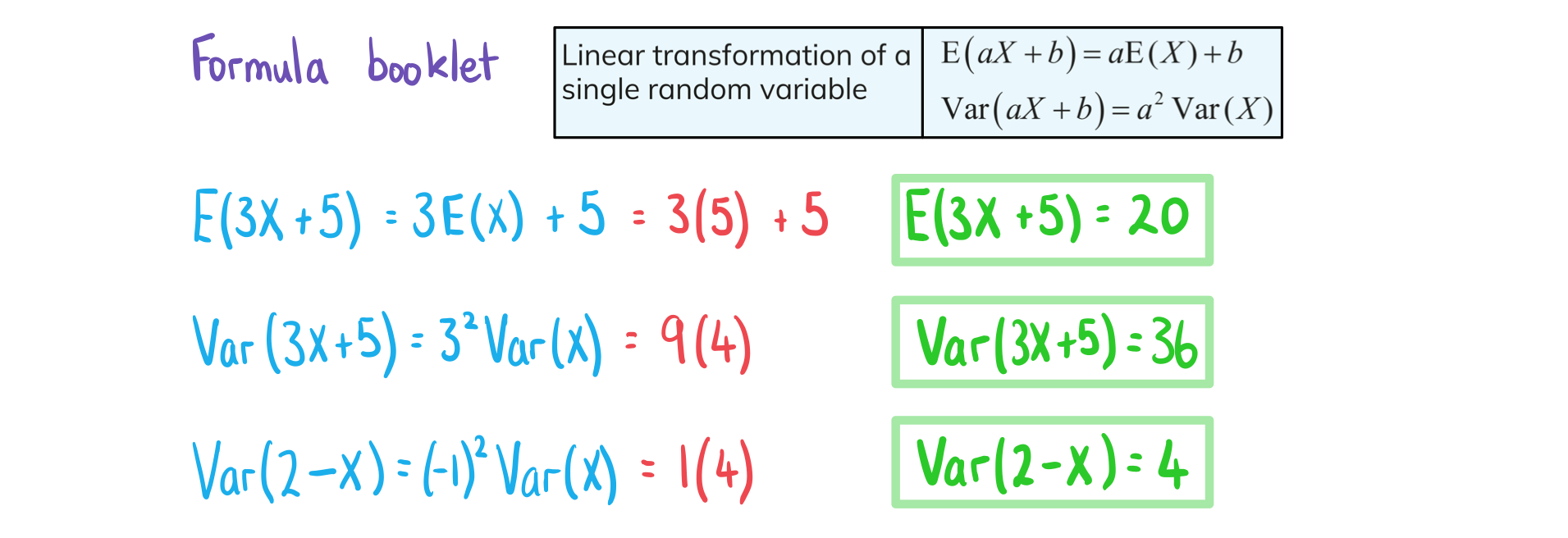Transformation of a Single Variable
What is Var(X)?
- Var(X) represents the variance of the random variable X
- Var(X) can be calculated by the formula
- where
- where
- You will not be required to use this formula in the exam
What are the formulae for E(aX ± b) and Var(aX ± b)?
- If a and b are constants then the following formulae are true:
- E(aX ± b) = aE(X) ± b
- Var(aX ± b) = a² Var(X)
- These are given in the formula booklet
- This is the same as linear transformations of data
- The mean is affected by multiplication and addition/subtraction
- The variance is affected by multiplication but not addition/subtraction
- Remember division can be written as a multiplication
Worked Example
is a random variable such that
and
.
Find the value of:
(i)
(ii)
(iii)

Transformation of Multiple Variables
What is the mean and variance of aX + bY?
- Let X and Y be two random variables and let a and b be two constants
- E(aX + bY) = aE(X) + bE(Y)
- This is true for any random variables X and Y
- Var(aX + bY) = a² Var(X) + b² Var(Y)
- This is true if X and Y are independent
- E(aX - bY) = aE(X) - bE(Y)
- Var(aX - bY) = a² Var(X) + b² Var(Y)
- Notice that you still add the two terms together on the right hand side
- This is because b² is positive even if b is negative
- Therefore the variances of aX + bY and aX - bY are the same
What is the mean and variance of a linear combination of n random variables?
- Let X1, X2, ..., Xn be n random variables and a1, a2, ..., an be n constants
-
- This is given in the formula booklet
- This can be written as
- This is true for any random variable
-
- This is given in the formula booklet
- This can be written as
- This is true if the random variables are independent
- Notice that the constants get squared so the terms on the right-hand side will always be positive
For a given random variable X, what is the difference between 2X and X1 + X2?
- 2X means one observation of X is taken and then doubled
- X1 + X2 means two observations of X are taken and then added together
- 2X and X1 + X2 have the same expected values
- E(2X) = 2E(X)
- E(X1 + X2) = E(X1) + E(X2) = 2E(X)
- 2X and X1 + X2 have different variances
- Var(2X) = 2²Var(X) = 4Var(X)
- Var(X1 + X2) = Var(X1) + Var(X2) = 2Var(X)
- To see the distinction:
- Suppose X could take the values 0 and 1
- 2X could then take the values 0 and 2
- X1 + X2 could then take the values 0, 1 and 2
- Questions are likely to describe the variables in content
- For example: The mass of a carton containing 6 eggs is the mass of the carton plus the mass of the 6 individual eggs
- This can be modelled by M = C + E1 + E2 + E3 + E4 + E5 + E6 where
- C is the mass of a carton
- E is the mass of an egg
- It is not C + 6E because the masses of the 6 eggs could be different
Exam Tip
- In an exam when dealing with multiple variables ask yourself which of the two cases is true
- You are adding together different observations using the same variable: X1 + X2 + ... + Xn
- You are taking a single observation of a variable and multiplying it by a constant: nX
Worked Example
and
are independent random variables such that
&
,
&
.
Find the value of:
(i)
(ii)
(iii)

